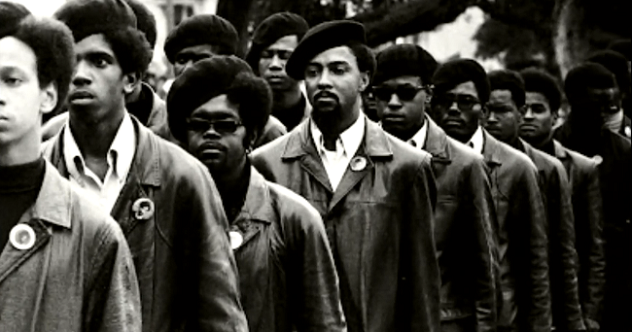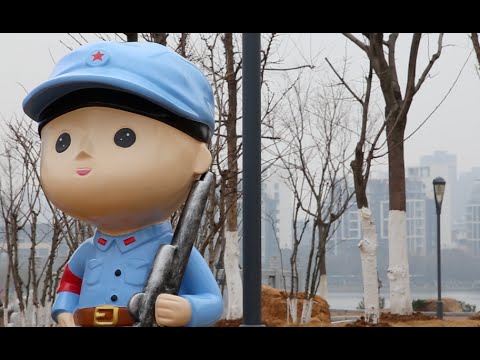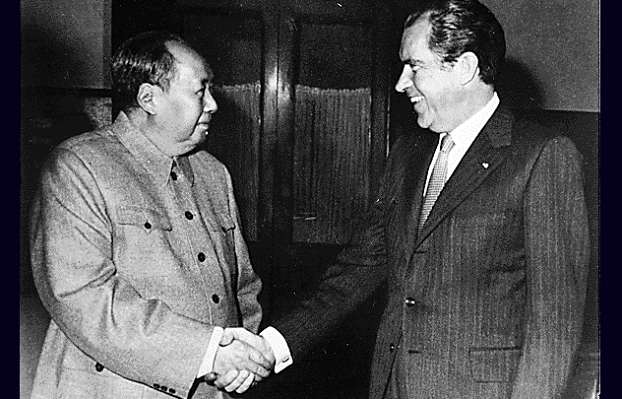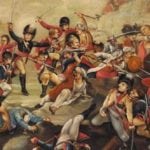We usually think of propaganda as a pretty straightforward concept. We might imagine it as something like a poster or news broadcast. However, manipulating people’s minds can take many forms. Over the years, it has gone in some interesting (and unusual) directions.
10 The Racist Coloring Book
The Black Panther Party was a shock to traditional white America. Many people were worried the group would become a violent threat. The FBI infiltrated and attempted to destroy the Panthers on several occasions. One of their strategies was to stoke fears that the group was dangerous. The FBI needed to shock both black and white Americans into denouncing the Black Panthers. What better way to do that than creating a violent coloring book for children? That is exactly what the FBI set out to do. Released in 1968, the coloring book portrayed white people as pigs and showed them getting brutalized by black rebels. The pages illustrated violence toward white store owners and white cops, in addition to portraying Black Panthers (armed with assault rifles) as radical freedom fighters. The intention of the coloring book was to reinforce the idea that the Black Panthers were a violent terrorist group that wanted to kill white people. Although it was created by the FBI, it was credited to the Panthers. Copies of the coloring book were distributed throughout white America, and most recipients were likely horrified. Obviously, the coloring book was directed toward children, and this made it even more shocking. Given that fact, the FBI seems to have been somewhat successful. Several black leaders stopped supporting the Panthers after the book’s publication.
9 Fabricated Prophecies
When people are in deep states of fear, they tend to gravitate toward the supernatural. After all, in times of danger, few know what will happen, and many feel like their families could be destroyed. So it’s only natural that people who claim to know the future are given open ears. During World War II, this behavior was turned into a psychological warfare strategy. Both the Allies and the Axis powers utilized fake prophecies to demoralize the other side. The British hired a German-Jewish astrologer to write fake predictions for top Nazis (including Hitler). The astrologer also published several predictions in German astrology magazines. They all spoke doom for the Nazi regime and predicted the Germans would lose the war. The astrologer was given speaking engagements in the United States where he also described the Nazi defeat. By the same token, the Germans saw the use of prophecy as valuable to their propaganda effort. Propaganda minister Joseph Goebbels spearheaded efforts to create fake Nostradamus prophecies of Allied defeat. The pamphlets were airdropped over Belgium and France during the war.
8 The Propaganda City
North Korea is famous for its flamboyant propaganda. The country is home to perhaps the biggest personality cult in the history of mankind. Since the North Koreans remain completely out of touch with the modern world, their culture is stuck in the 1950s Soviet era . . . and so are their propaganda skills. In the 1950s, North Korea wanted to convince unhappy South Koreans to cross the border into “paradise.” Their strategy was to display North Korean success to otherwise poor South Koreans. How did they attempt to do this? By building an entire city. The city of Kijong-dong was built shortly after the Korean War. It’s situated right on the South Korean border where everyone can see it. It’s been dubbed the “Propaganda Village” by foreigners and “Peace Village” by North Korea. The town contains buildings with striking blue rooftops, electric lighting, hospitals, schools, and one of the world’s largest flag poles. The little city is kept clean, and North Korea claims 200 people call the village home. If you’re a poor South Korean farmer, it might seem like a nice place to live. However, the truth is a bit different. South Korea has been observing the city for decades, and they’ve concluded that the whole thing is fake. The buildings have no windows, there are automated lights, and there aren’t any inhabitants. There is the occasional “maintenance crew” that cleans things up, but that’s about it. North Korea doesn’t seem to have been successful in luring South Koreans over the border, either. For years, they tried to stoke the fire by blasting constant propaganda from the city. Nobody took the bait, and Kijong-dong remains empty.
7 The Sexual Jealousy Airdrops
Countless men were forced to leave their families and fight during World War II. These men endured untold amounts of stress. It’s likely that the only thing keeping some of them sane were their wives back home. The Germans decided to capitalize on that. To stoke feelings of jealousy, the Nazis airdropped thousands of leaflets on Allied soldiers. One batch was dropped on the French front. The images portrayed British soldiers taking advantage of French women. Other leaflets showed French draft dodgers helping themselves to innocent French women while the hardworking soldiers fought on the front lines. Another batch of propaganda was aimed at the Americans. The Nazis created posters that implied their wives and girlfriends were going out on sexual free-for-alls while they were stationed in Europe. Truly, nothing could be more gut-wrenching. Of course, the Polish soldiers were not left out of the propaganda effort. They were bombarded with images of Jews having sex with their significant others.
6 China’s Communist Theme Park
Modern China is something of an enigma. It’s difficult to call it communist, but it’s just as hard to call it capitalist. The country has been opening up to the free market, and the gap between rich and poor has been growing. However, China still holds onto remnants of censorship and propaganda that remind us of good old Soviet-style communism. In perhaps one of its most brazen propaganda efforts, China recently opened a huge (3 million square feet) amusement park for “educational” purposes. The new park is littered with symbols of the Chinese Communist Party. The park contains artwork, statues, and engravings of important communists. The statues depict children dressed up in communist uniforms and holding copies of chairman Mao’s Little Red Book. There are also figures of kids who are portrayed as Olympic athletes and astronauts. Indeed, it appears that the whole purpose of the park is to brainwash children. Solidifying this idea is a featured area where children can sign up to join the “Communist Youth League.” By joining, their communist loyalty can be developed at a young age. This park is the first of six of its kind to be built. Communist tourism has become a booming industry in China. There are countless national attractions scattered throughout the country. Chinese leader Xi Jinping summed up the government’s involvement in the industry in a recent speech. He stated that, “We need to seize these two concepts—red bases and patriotic education on the one hand and developing red tourism on the other.” China seems set on propping up its nationalistic pride. However, Chinese citizens may not be totally on board. Several people have expressed intense criticism of the communist theme park. They’ve lobbed attacks online, calling it a “waste of money” and writing that the park’s purpose is nothing short of brainwashing. Given the overwhelming amount of adult criticism, it’s no wonder the government is going after the youth.
5 The Comic Book Psy-War
Comic books are a symbol of national pride in the United States. Superheroes like Captain America and Superman have reinforced American stereotypes for decades. However, the beginnings of the comic book industry were rife with propaganda. Before World War II, comic books were just getting off the ground, and the United States Information Office saw superheroes as a valuable way to influence American minds. For this reason, the government designed and distributed large numbers of comics. Commercial companies also followed suit, and soon the US was flooded with pro-war comics. During World War II, the comics tended to dehumanize the Axis powers and show them as weak. The enemies were portrayed as no match for the powerful American superheroes who fought them. They also racially stereotyped the Japanese in ways that would cause a national uproar today. This same psychological warfare strategy continues even now. Comics have been utilized in military and political conflicts such as the Korean War, the Vietnam War, the Cold War, and the recent wars in Afghanistan and Iraq. In some cases, they’ve been distributed on the home front. In others, they’ve been spread in foreign countries. In recent years, the United States military has developed a whole array of comics aimed at Iraqis. They portray the Iraqi soldiers and police as ultra-cool superheroes who crush the weak insurgents. It seems that this propaganda method isn’t going anywhere. Apparently, it works too well.
4 Counterfeit Money
Money is essential for everyone living in society. There is hardly a better way to influence people than to bring money into the equation. For that reason, it has been used in psychological warfare for decades. In Vietnam, the United States airdropped counterfeit Vietnamese currency on civilians. The bank notes contained dire messages. They warned that the communists would soon bankrupt the nation with their useless war and that innocent people would spiral into complete poverty. During World War II, the counterfeit money strategy was also widespread. Several Asian nations were “money bombed” by the Allies. Each time, there was a psychological warfare message printed on the currency. The United States saturated the Japanese with fake bank notes which attempted to sow distrust in their government. The British also dumped fake money on Malaysia (then occupied by Japan) which stated that Japanese currency would become worthless. Soon, they said, British currency would be the replacement.
3 Altered Postage Stamps
Correspondence is an essential part of any war, and in World War II, controlling the postal system meant controlling messages. For that reason, the Allies and the Axis powers hijacked each others’ postage stamps. Postage stamps were subtly altered and sent to enemy territory during World War II. The Allies changed the appearance of Hitler and Mussolini on common Axis stamps. They portrayed them as looking scared or evil. In some cases, they even turned Hitler’s head into a creepy skull. The Allies also tried to sow division within the Nazi ranks by putting top Nazi leaders on stamps instead of Hitler. The Axis powers were also taking part in “stamp warfare.” They sent out stamps containing images of Allied leaders with slanderous messages printed upon them. They even replaced an image of the British Queen on some stamps with one of Stalin.
2 Soccer Balls For Civilians
Soccer is perhaps the most popular sport in the world. People across the globe watch, play, and the follow the sport quite religiously. However, the United States is an exception to the rule. The country is famous for caring very little about the sport. Even so, the United States is more than ready to use the game for propaganda purposes. In Iraq and Afghanistan, thousands of free soccer balls were handed out to the locals. In Iraq, senior psychological operations operatives spread soccer balls and jerseys to hundreds of young Iraqis. The PSYOPs branch of the United States Army called this “merchandising,” and they described how writing “Gift of the United States” on a soccer ball would win people over. Unfortunately, this strategy didn’t win hearts and minds in Afghanistan. Soccer balls were handed out in large numbers, but they were all covered with the Islamic declaration of faith, “There is no God but Allah, and Muhammad is his Messenger.” Naturally, many Muslims felt insulted and didn’t want to kick a ball displaying their sacred declaration.
1 Clothing And Appearance
The way people dress can display their culture and individuality. So controlling the way people style themselves could influence their sense of self-identity. With that in mind, it should come as no surprise that certain regimes have tried to alter the way people present themselves. Communist China was one of the biggest culprits. For centuries, this Asian country had unique clothing styles that were distinctly symbolic of its Chinese culture. After Mao came to power, that all changed. People were dressed in generic, dull, and monochrome clothing that showed no distinction. Everyone was reared in a collectivist culture where individual expression did not exist. Chinese leaders began wearing dreary, gray suits (later called “Mao suits”). Soon, wearing such clothing became part of the culture. People who refused were seen as strikingly unpatriotic. Although the situation in China has changed, North Korea has continued where the Chinese left off. They have banned all clothing other than state-sponsored fashions. They even have “fashion police” that makes sure people only dress in ways that would make “The Great Leader” proud. Derek is a professional writer who enjoys learning and spreading knowledge. Follow him on Twitter or send him an email.
























